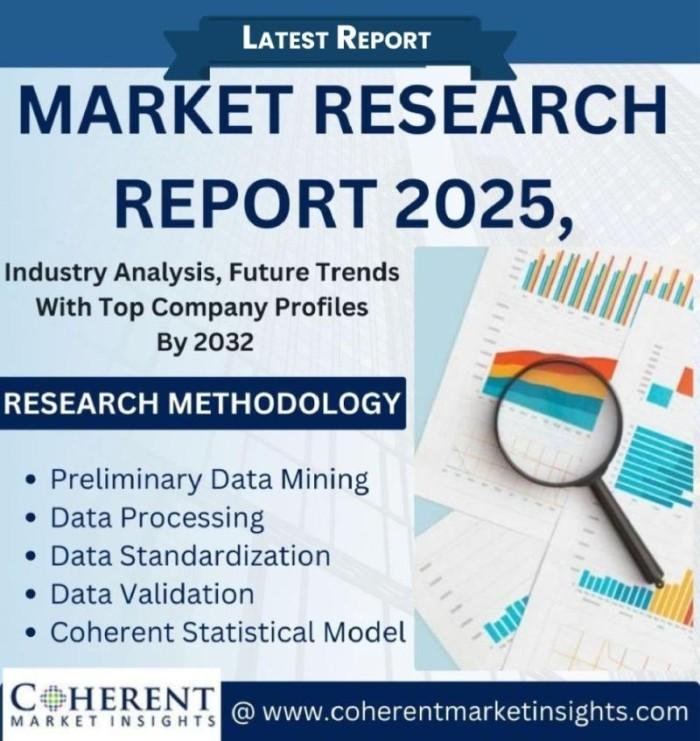AI Research
Drug Discovery Informatics Market Booming with AI-Driven

The Drug Discovery Informatics industry is witnessing transformative growth driven by advancements in computational technologies and increasing demand for efficient drug development processes. Advanced algorithms, AI, and machine learning techniques are revolutionizing how pharmaceutical research is conducted, substantially shortening the drug discovery lifecycle. The integration of big data analytics with traditional pharmaceutical research is enabling deeper insights and fostering innovation at an unprecedented pace. The Global Drug Discovery Informatics Market size is estimated to be valued at USD 2.1 billion in 2025 and is expected to reach USD 4.5 billion by 2032, exhibiting a compound annual growth rate (CAGR) of 11.2% from 2025 to 2032.
Request a Sample Copy with More Details: https://www.coherentmarketinsights.com/insight/request-sample/224
➤Actionable Insights
● Supply-side indicators reveal a steady increase in production capacity for drug informatics platforms, with deployment by leading pharmaceutical companies up by 18% in 2024 compared to the prior year.
● Pricing models have stabilized due to competitive cloud computing costs, with average subscription fees for informatics software decreasing by 7% in 2025, facilitating wider uptake.
● Imports of cutting-edge informatics solutions have grown notably in emerging pharma hubs like India and China, growing 21% year-over-year in 2024.
● Use cases have expanded beyond conventional pharma applications into biotech, CROs, and academic research, with 34% of new user acquisition driven by precision medicine initiatives.
● Micro-indicators show increased integration of nanoinformatics modules supporting molecule-level simulation, enhancing data granularity and predictive accuracy.
➤Market Segment and Regional Coverage
● By Informatics Solution Type: Data Management, Predictive Analytics, Molecular Modeling, Clinical Informatics, and Others.
● By End User: Pharmaceutical Companies, Biotechnology Firms, Contract Research Organizations (CROs), Academic & Research Institutes, and Others.
● By Deployment: On-Premise, Cloud-Based, and Hybrid Models.
Regional and Country Analysis:
● North America: U.S. and Canada
● Latin America: Brazil, Argentina, Mexico, and Rest of Latin America
● Europe: Germany, U.K., Spain, France, Italy, Benelux, Denmark, Norway, Sweden, Russia, and Rest of Europe
● Asia Pacific: China, Taiwan, India, Japan, South Korea, Indonesia, Malaysia, Philippines, Singapore, Australia, and Rest of Asia Pacific
● Middle East & Africa: Bahrain, Kuwait, Oman, Qatar, Saudi Arabia, United Arab Emirates, Israel, South Africa, North Africa, Central Africa, and Rest of MEA
➤Key Players
● Thermo Fisher Scientific
● BIOVIA (Dassault Systèmes)
● Schrödinger, Inc.
● Certara, Inc.
● Accelrys, Inc.
● PerkinElmer, Inc.
● OpenEye Scientific Software
● Genedata AG
● Elsevier (Reaxys)
● Sapio Sciences, LLC
● Ben-Achiel Software LLC
● ChemAxon Ltd
● Moleculera Labs
● ChemDiv, Inc.
● Medidata Solutions
● Recent competitive strategies include Thermo Fisher Scientific’s 2024 acquisition of PPD’s analytics division, enabling expansion in clinical informatics services and boosting market reach by 15% in North America within six months.
● Schrödinger’s integration of AI-powered predictive analytics in 2025 led to 22% improvement in drug candidate identification efficiency, solidifying its position among market players focused on innovation-led growth.
✅ Get Full Research Report: https://www.coherentmarketinsights.com/market-insight/drug-discovery-informatics-market-224?utm_source=openpr.com&utm_medium=referral
➤Growth Factors
● The escalating demand for personalized medicine is a pivotal driver, pushing investments in informatics for targeted drug design, with a reported 30% increase in funding in 2024.
● Regulatory pressure for data transparency and reproducibility continues to expand the market scope as companies deploy advanced informatics to comply with evolving standards globally.
● Increasing collaborations between pharmaceutical firms and tech companies are fostering business growth through shared expertise and resource optimization. For instance, a 2025 partnership between a leading pharma company and a cloud service provider resulted in 25% reduction in R&D timelines.
➤ Market Trends
● Integration of AI and machine learning models with laboratory automation is streamlining drug discovery workflows, evidenced by a 28% rise in automated experiment adoption in 2025.
● Cloud-based informatics solutions are gaining traction due to scalability and cost efficiency, with cloud deployments growing to 60% of all installations in 2025, reflecting a strong market trend.
● Increasing incorporation of real-world data (RWD) and real-world evidence (RWE) in predictive analytics supports more robust clinical trial designs and faster go-to-market strategies.
● Multi-omics data interpretation tools have emerged as a key trend, enabling comprehensive biological insights that drive innovation in biomarker discovery and novel drug targets.
➤Key Takeaways
● Drug Discovery Informatics Market size is poised for significant expansion, driven by technological advancements and increased pharma investments.
● Data Management remains the dominant segment, with emphasis on secure and efficient handling of large-scale biological data sets.
● Cloud-Based deployment is experiencing rapid growth due to lower costs and enhanced collaboration capabilities.
● North America continues to lead in innovation-driven market dynamics supported by robust R&D infrastructure.
● The Asia Pacific region is emerging as a vital hub for cost-effective drug research leveraging informatics tools.
● Personalized medicine adoption enhances market opportunities, particularly in biotechnology end users.
✅Purchase This Premium Research Report and Get Upto 25% Discount at: https://www.coherentmarketinsights.com/insight/buy-now/224
❓ Frequently Asked Questions
1. Who are the dominant players in the Drug Discovery Informatics market?
The market is led by companies such as Thermo Fisher Scientific, Schrödinger, and BIOVIA (Dassault Systèmes), which focus heavily on innovation and strategic acquisitions to expand their portfolio and geographic outreach.
2. What will be the size of the Drug Discovery Informatics market in the coming years?
The market size is estimated to be USD 2.1 billion in 2025 and is expected to nearly double to USD 4.5 billion by 2032, growing at a CAGR of 11.2%.
3. Which end user industry has the largest growth opportunity?
Pharmaceutical companies and biotechnology firms hold the largest growth potential given their extensive R&D investments and ongoing expansion of personalized medicine initiatives.
4. How will market development trends evolve over the next five years?
Emerging trends such as cloud-based deployment, integration of AI & machine learning, and enhanced multi-omics analysis are expected to dominate, accelerating drug discovery timelines and improving predictive accuracies.
5. What is the nature of the competitive landscape and challenges in the Drug Discovery Informatics market?
Competition is characterized by rapid innovation, strategic acquisitions, and partnerships. Challenges include data privacy concerns, high integration costs, and the need for continuous technology upgrades.
6. What go-to-market strategies are commonly adopted in the Drug Discovery Informatics market?
Market companies frequently adopt strategies including mergers and acquisitions, technology integration, cloud service expansion, and regional market penetration, as seen in the strategic moves by Thermo Fisher Scientific and Schrödinger in recent years.
Author of this marketing PR:
Alice Mutum is a seasoned senior content editor at Coherent Market Insights, leveraging extensive expertise gained from her previous role as a content writer. With seven years in content development, Alice masterfully employs SEO best practices and cutting-edge digital marketing strategies to craft high-ranking, impactful content.
About Us:
Coherent Market Insights leads into data and analytics, audience measurement, consumer behaviors, and market trend analysis. From shorter dispatch to in-depth insights, CMI has exceled in offering research, analytics, and consumer-focused shifts for nearly a decade. With cutting-edge syndicated tools and custom-made research services, we empower businesses to move in the direction of growth. We are multifunctional in our work scope and have 450+ seasoned consultants, analysts, and researchers across 26+ industries spread out in 32+ countries.
Contact Us:
533 Airport Boulevard, Suite 400, Burlingame, CA 94010, United States
United States of America: +1-252-477-1362
United Kingdom: UK Number: +442039578553
Australia: +61-8-7924-7805
India: +91-848-285-0837
Email: sales@coherentmarketinsights.com
This release was published on openPR.
AI Research
Artificial intelligence (AI)-powered anti-ship missile with double the range

Questions and answers:
- What is the primary feature of the LRASM C-3 missile compared to earlier variants? It has nearly double the range of previous versions, with a range of about 1,000 miles, compared to 200 to 300 miles for the C-1 and 580 miles for the C-2.
- How does artificial intelligence enhance the LRASM C-3’s capabilities? AI helps the missile with autonomous mission planning, target discrimination, and attack coordination, adjust flight paths based on real-time data, identify and track moving targets, and adapt to changing conditions like jamming and interference.
- What can launch the LRASM C-3 missile? U.S. Air Force B-1B bombers, Navy F/A-18E/F Super Hornets, and F-35 Lightning II jets, with possible future launches from Navy ships and attack submarines.
PATUXENT RIVER NAS, Md. – U.S. Navy surface warfare experts are asking Lockheed Martin Corp. to move forward with developing the new LRASM C-3 anti-ship missile with double the range of previous versions.
Officials of the Naval Air Systems Command at Patuxent River Naval Air Station, Md., announced a $48.1 million order last month to the Lockheed Martin Missiles and Fire Control segment in Orlando, Fla., for engineering to establish the Long Range Anti-Ship Missile (LRASM) C-3 variant.
The subsonic LRASM is for attacking high-priority enemy surface warships like aircraft carriers, troop transport ships, and guided-missile cruisers from Navy, U.S. Air Force, and allied aircraft.
LRASM is designed to detect and destroy high-priority targets within groups of ships from extended ranges in electronic warfare jamming environments. It is a precision-guided, standoff anti-ship missile based on the Lockheed Martin Joint Air-to-Surface Standoff Missile-Extended Range (JASSM-ER).
1,000-mile range
The LRASM C-3 variant has a range of nearly 1,000 miles, compared to the 200-to-300-mile C-1 variant, and 580-mile range of the LRASM C-2 variant.
LRASM C-3 also introduces machine learning and advanced artificial intelligence (AI) algorithms to enhance autonomous mission planning, target discrimination, and attack coordination, even amid intense electronic warfare (EW) jamming.
The C-3 also can exchange information from military satellites, and has an enhanced imaging infrared and RF seeker for survivability and target identification.
The C-3 also can be launched form the Air Force from B-1B strategic jet bomber, as well as the Navy F/A-18E/F Super Hornet jet fighter-bomber and the F-35 Lightning II attack jet. Navy leaders also envision using the Navy MK 41 shipboard vertical launch system with the LRASM C-3, and are considering options to launch the missile from attack submarines.
Tell me more about applying artificial intelligence to missile guidance …
- Applying artificial intelligence to missile guidance will enhance precision, adapt to dynamic environments, and improve decision-making in real-time. AI can help missiles navigate autonomously by using real-time data from radar, infrared sensors, and GPS to adjust flight paths. AI also can help missiles visually identify targets from images or video feeds, and not only enhance the missile’s ability to recognize and track moving targets, but also to predict and follow moving targets even if they change direction or speed. Using AI, missile guidance systems can make real-time adjustments to their trajectory based on changing conditions like wind, RF interference, and jamming. Missiles also may use AI to other weapons in swarm tactics, and operate effectively against countermeasures.
Helping to extend the LRASM C-3’s range are an advanced multi-mode sensor suite; enhanced data exchange and communications; digital anti-jam GPS and navigation; and AI and machine learning capabilities.
The missile’s multi-mode sensor suite is expected to blend imaging infrared and RF sensors to help the weapon identify and attack targets. Its communications will have data links for secure real-time communication with satellites, drones, and strike aircraft.
Digital anti-jam GPS and navigation will provide midcourse guidance to target areas far beyond the effective range of traditional systems. AI and machine learning, meanwhile, should help the missile identify targets and plan its routes autonomously. The LRASM C-3 version should enter service next year.
On this order, Lockheed Martin will do the work in Orlando and Ocala, Fla.; and in Troy, Ala., and should be finished in November 2026. For more information contact Lockheed Martin Missiles and Fire Control online at https://www.lockheedmartin.com/en-us/products/long-range-anti-ship-missile.html, or Naval Air Systems Command at www.navair.navy.mil.
AI Research
Human-Machine Understanding in AI | Machine Precision Meets Human Intuition

AI Research
How to Scale Up AI in Government

State and local governments are experimenting with artificial intelligence but lack systematic approaches to scale these efforts effectively and integrate AI into government operations. Instead, efforts have been piecemeal and slow, leaving many practitioners struggling to keep up with the ever-evolving uses of AI for transforming governance and policy implementation.
While some state and local governments are leading in implementing the technology, AI adoption remains fragmented. Last year, some 150 state bills were considered relating to the government use of AI, governors in 10 states issued executive orders supporting the study of AI for use in government operations, and 10 legislatures tasked agencies with capturing comprehensive inventories.
Taking advantage of the opportunity presented by AI is critical as decision-makers face an increasing slate of challenging implementation problems and as technology quickly evolves and develops new capabilities. The use of AI is not without risks. Developing and adapting the necessary checks and guidance is critical but can be challenging for such dynamic technologies. Shifting from seeing AI as merely a technical capability to considering what AI technology should be asked to do can help state and local governments think more creatively and strategically. Here are some of the benefits governments are already exploring:
Administrative efficiency: Half of all states are using AI chatbots to reduce administrative burden and free staff for substantive and creative work. The Indiana General Assembly uses chatbots to answer questions about regulations and statutes. Austin, Texas, streamlines residential construction permitting with AI, while Vermont’s transportation agency inventories road signs and assesses pavement quality.
Research synthesis: AI tools help policymakers quickly access evolving best practices and evidence-based approaches. Overton’s AI platform, for example, allows policymakers to identify how existing evidence aligns with priority areas, compare policy approaches across states and nations, and match with relevant researchers and projects.
Implementation monitoring: AI fills critical gaps in program evaluation without major new investments. California’s transportation department analyzes traffic patterns to optimize highway safety and inform infrastructure investments.
Predictive modeling: AI-enabled models help test assumptions about which interventions will succeed. These models use features such as organizational characteristics, physical and contextual factors, and historical implementation data to predict success of policy interventions, and their outputs can help tailor interventions and improve outcomes and success. Applications include targeting health interventions to patients with modifiable risk factors, identifying lead service lines in municipal water systems, predicting flood response needs and flagging households at eviction risk.
Scaling up to wider adoption in policy and practice requires proactive steps by state and local governments and attendant guidance, monitoring and evaluation:
Adaptive policy framework: AI adoption often outpaces planning, and the definition of AI is often specific to its application. States need to define AI applications by sector (health, transportation, etc.) and develop adaptive operating strategies to guide and assess its impact. Thirty states have some guidance, but comprehensive approaches require clear definitions and inventories of current use.
Funding strategies: Policymakers must identify and leverage funding streams to cover the costs of procurement and training. Federal grants like the State and Local Cybersecurity Grant Program offer potential, though current authorization expires this Sept. 30. Massachusetts’ FutureTech Act exemplifies direct state investment, authorizing $1.23 billion for IT capital projects including AI.
Smart procurement: Effective AI procurement requires partnerships with vendors and suppliers and between chief information officers and procurement specialists. Contracts must ensure ethical use, performance monitoring and continuous improvement, but few states have procurement language related to AI. Speed matters — AI purchases risk obsolescence during lengthy procurement cycles.
Training and workforce development: Both current and future state and local government workforces need AI skills. Solutions include AI training academies and literacy programs for government workers, joint training programs between professional associations, and the General Services Administration’s AI Community of Practice‘s events and training. The Partnership for Public Service has recently opened up its AI Government Leadership program to state and local policymakers. Universities including Stanford and Michigan offer specialized programs for policymakers. Graduate programs in public policy, administration and law should incorporate AI governance tracks.
State AI policy development involves governor’s offices, chief information offices, security offices and legislatures. But success requires moving beyond pilot projects to systematic implementation. Governments that embrace this transition will be best positioned for future challenges. The opportunity exists now to set standards for AI-enabled governance, but it requires proactive steps in policy development, funding, procurement, workforce development and safeguards.
Joie Acosta is a senior behavioral scientist and the Global Scholar in Translation at RAND, a nonprofit, nonpartisan research institute. Sara Hughes is a senior policy researcher and the Global Scholar of Implementation at RAND and a professor of policy analysis at the RAND School of Public Policy.
Governing’s opinion columns reflect the views of their authors and not necessarily those of Governing’s editors or management.
-

 Business2 weeks ago
Business2 weeks agoThe Guardian view on Trump and the Fed: independence is no substitute for accountability | Editorial
-
Tools & Platforms1 month ago
Building Trust in Military AI Starts with Opening the Black Box – War on the Rocks
-

 Ethics & Policy2 months ago
Ethics & Policy2 months agoSDAIA Supports Saudi Arabia’s Leadership in Shaping Global AI Ethics, Policy, and Research – وكالة الأنباء السعودية
-

 Events & Conferences4 months ago
Events & Conferences4 months agoJourney to 1000 models: Scaling Instagram’s recommendation system
-

 Jobs & Careers2 months ago
Jobs & Careers2 months agoMumbai-based Perplexity Alternative Has 60k+ Users Without Funding
-

 Podcasts & Talks2 months ago
Podcasts & Talks2 months agoHappy 4th of July! 🎆 Made with Veo 3 in Gemini
-

 Education2 months ago
Education2 months agoMacron says UK and France have duty to tackle illegal migration ‘with humanity, solidarity and firmness’ – UK politics live | Politics
-

 Education2 months ago
Education2 months agoVEX Robotics launches AI-powered classroom robotics system
-

 Funding & Business2 months ago
Funding & Business2 months agoKayak and Expedia race to build AI travel agents that turn social posts into itineraries
-

 Podcasts & Talks2 months ago
Podcasts & Talks2 months agoOpenAI 🤝 @teamganassi



















